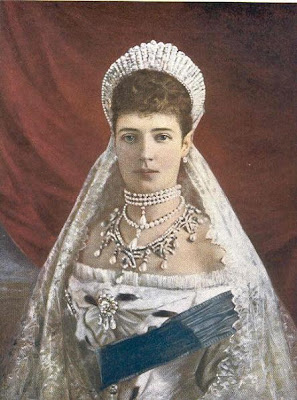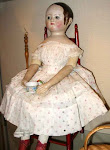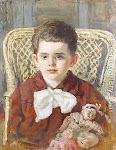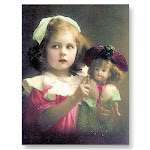One of the most tragic figures of European royalty is the Empress Maria-Feodorovna, widow of Alexander III, and mother of Nicholas II of Russia. She was born to be Princess Dagmar of Denmark and later became Empress consort of Russia spouse of Emperor Alexander III.

 Charcoal sketch ca. 1880
Charcoal sketch ca. 1880Dagmar and her siblings, including Alexandra, became consorts to royal houses throughout Europe and Russia and this formed the basis of alliances for culture, industry and war throughout the 19th and 20th centuries. Alexandra married Edward, the Prince of Wales, while Dagmar attracted the attention of her Russian cousin resulting in her marriage to the Grand Duke Alexander Alexandrovich of the Romanov family in Russia.

 Maria Fyodorovna Empress of Russia.
Maria Fyodorovna Empress of Russia.
Following Romanov court custom, Dagmar adopted the Orthodox religion under the name of Maria-Fyodorovna, after which Alexander and the newly baptized Maria were married in a sumptuous ceremony in St. Petersburg.
 Family portrait.
Family portrait. "The Empress Dowager"
"The Empress Dowager"Maria-Fyodorovna was a devoted, doting mother who spoiled her children. She refused to let her five surviving children to grow, particularly her eldest son, the future Nicholas II. Consequently, the imperial children were completely unprepared for the role history had in store for them. Tsarevich Nicholas was most unsuited for the role of Tsar of Russia, a reality expressed by Nicholas himself soon after his father's death when he lamented "what is going to happen to Russia?....I am not prepared...I know nothing of the business of ruling."
 Gatchina Palace
Gatchina PalaceThe Imperial court was still in mourning for the death of Tsar Alexander III. It was not an auspicious beginning for the new reign.
 Countess Dagmar parian doll.
Countess Dagmar parian doll.Nicholas II married Alix of Hesse and by Rhine (Queen Victoria of England granddaughter) later to be Alexandra. Alix carried the gene for the "royal disease" (hemophilia), which their only son and heir was born with. This brought Nicholas and Alexandra closer to each other, but separated them from the Russian people and the Imperial family, including her powerful mother-in-law The Empress Dowager Maria Feodorovna.
Ultimately, this seclusion resulted in rumors and discontent grew in the country ending with the assassination of the royal family during the Bolshevik revolution.
 Maria received reports that her sons, her daughter-in-law and her grandchildren had been murdered. In her diary she comforted herself: "I am sure they all got out of Russia and now the Bolsheviks are trying to hide the truth." She firmly held on to this conviction until her death.
Maria received reports that her sons, her daughter-in-law and her grandchildren had been murdered. In her diary she comforted herself: "I am sure they all got out of Russia and now the Bolsheviks are trying to hide the truth." She firmly held on to this conviction until her death.












































.jpg)


















































































Not sure how comfortable the clothes would have been but just love the style. Alexander had more my build (lol)
ReplyDeleteThis was a most interesting post as my Family is from those regions of Russia and Ukraine. I always loved the History there.
ReplyDeleteI loved the Conta Boehme china doll, very pretty colour. Thank you for the history and beautiful pictures, I really enjoy looking at them. Just glad I don't have to wear any of those dresses, they sure don't look very comfortable.
have a great day!
Thank you Erica and Hermes...I agree about the clothes. I don't know how they could move with those garments!
ReplyDeleteI love the history of Europe, and the turn of the century was a time of tumultuos events indeed. The Romanovs story was one of those very sad moments.
I am glad you enjoyed this post.
Очень интересная информация! Спасибо большое. Красавицей в современном понимании назвать нельзя, но что-то такое притягивающее есть во взгляде, в выражении лица. А куклы просто великолепны!
ReplyDeleteСпасибо Tamravvo! Я рад, что вам нравится этот пост. Романовых была такая печальная история неправильно. Трагедия, с ужасной смертью семьи всегда пострадавших меня. Особенно молодых девушек и их сладкий брат.Благодарю вас за после моего блога.
ReplyDeleteМарта
Haces que la Historia parezca fácil. ¡Yo siempre he sido un negado! Con tus posts, resulta muy agradable enterarse de estas historias, siempre muy dramáticas. Me ha gustado muchísimo la Kister Parian doll. El vestido es una joya.
ReplyDeleteY todos los retratos de estos personajes, son increíblemente bonitos.
Muchas gracias por instruirme.
Un beso.
Albero....
ReplyDeleteMe facina la historia...Siempre temo aburrir a mis seguidores que solos estan interesados en munecas, aunque solo escribo de personajes que han afectado de tal manera la historia, que se crearon munecas en sus imagenes. Espero que comprendan mis motivos en documentar una fraccion de sus vidas tan increibles.